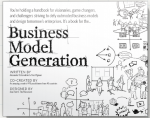Developing a new business idea is notoriously difficult. Start-up failure statistics are discouraging – some 90 per cent of all new ventures fail, about 40 per cent of all new products or services cannot find sufficient buyers.
What prompted your interest in business model design?
During the 1990s the term “business model” became popular. It was associated with the wave of e-commerce firms that emerged during the dot com boom. But although the term was widely used it wasn’t well defined.
On campus a lot of students wanted to create internet start-ups. Many came to me asking for help checking their business plan – e-business was part of my teaching at the time. For most of these entrepreneurs the business plan was their only start-up tool. It seemed strange to me to use a business plan – good for planning three to five years ahead – for a situation like start-ups where you are usually unable to plan your activities in the next six months, let alone three years.
What did you suggest instead?
Initially I had questions I would ask them, about their customers, distribution channels, and other aspects of starting a business. But then it occurred to me that I should apply my information systems design expertise to the challenge of business model design. Together with my co-author Alex Osterwalder we designed a business model ontology – a definition of the different concepts relating to the business model and how they fit together. We completed that tool towards the end of 2004.
This was published in Business Model Generation?
Take a peek:
The initial idea emerged in Alex’s PhD thesis, under my supervision, and then was refined through published academic papers and cases. But once it became clear that practitioners were interested, we decided to create a simplified version of the business model ontology. Between 2004 and 2008 we created the business model canvas and wrote the book Business Model Generation at that time.
And part of that business model canvas is “value proposition”, the subject of your most recent book.
Take a peek:
Yes. After the first book was published we did a lot of workshops, presentations and other activities related to our concept. It soon became clear that value proposition was an area people found difficult to define or design. So we decided to work on an add-on tool called the Value Proposition Canvas. We tested the canvas during lectures, seminars and workshops, and then wrote the book that was published in 2014.
What’s difficult to understand about value proposition? Why is it important to get right?
Big corporations especially, but also start-ups, tend to focus on the product or service they want to offer. The idea of a good fit with customers comes second, when they come to deal with the marketing issues. Yet one of the main reasons for start-up failure is creating a product nobody wants.
Why do you think companies often focus on the product first?
Well in organizations with big R&D budgets, R&D tends to have a lot of influence. Then the focus is usually on the product.
Also, larger companies often have siloes. One group of people do R&D, another group is responsible for marketing. One group focuses on generating new products, then another group takes those products and pushes them into the market. You don’t often see R&D, marketing and sales working together on this. It’s different with small start-ups which are far less siloed, yet even for them value proposition design is complicated.
What needs to happen?
You need to understand your customers and check the fit between value proposition and customer, right from the beginning.
What are some essential elements of value proposition design?
To create a value proposition, first you need to understand your customers; to put yourself in their shoes. Traditionally, that means asking customers what they want. An alternative approach, however, is trying to understand exactly, the jobs-to-get-done, what the customer does during a particular activity. Break the activity down into its constituent tasks. Take air travel, for example, the customer must find the right destination, choose a flight, book the flight, check-in, negotiate security, board the flight, occupy themselves during the flight, and so on.
Once you have established the actions and tasks required you can analyze those tasks from two perspectives: identifying pains or problems – the obstacles that detract from the overall customer experience; and identifying gains or benefits – features that would enhance the experience.
You collect data using various methods, you might ask questions, or adopt an anthropological approach by observing customers, there are many techniques. But eventually you will have a list of the different tasks, and a list of problems and potential benefits. These can be ranked as well.
And after that?
With the first step you have obtained a profile of your customer and the way they behave. You have a better understanding of your customers. Now you can begin to design and prototype possible value propositions. Drawing on the customer profile findings, ask what features you can offer the customers that will address any problems (pain relievers) or deliver any benefits (gain creators) that were identified.
You might, for example, decide that instead of selling a particular item of machinery you will lease it, or charge on a usage basis, or bundle it up with other services.
The designing and prototyping stages involve generating alternatives and evaluating their strengths and weaknesses. It is about opening up the process. It’s a kind of brainstorming activity. Then you close down the process, selecting the propositions you think will be the most interesting for customers.
You advocate testing value propositions at an early stage?
Yes. When you have some ideas you need to check them. The time to do this is not once everything is built. You want to test your value propositions with some customers and collect feedback before launching companies and investing lots of money.
Identify the hypotheses in your value proposition and business model. It might be cutting customer costs by 10 per cent, for example. Although you might assume, using your knowledge and experience, that this would be profitable, it is better to test your hypothesis.
You could ask customers whether they would buy on the basis of a ten per cent saving. But what customers say and do are often different. Another technique, though, which we advise in addition to any interviews, is to ask customers to do something that shows that they are interested in the proposition. Tell them, for example, that they can find out more about your proposition by visiting your website. If half the people interviewed visit the website, click on a particular link, and provide some requested information – an email address, or mailing address, or credit card details, for example – you know they’re interested in the product or service. It’s collecting data based on a ‘call to action’.
Checking their willingness to pay is much more important than just checking their interest in an idea. If you can see that they are willing to engage with you, it confirms that potentially you have an interesting value proposition.
Once you have checked one hypothesis relating to your value proposition – a discount that you plan to offer, for example – then you can test another – the type of product, perhaps.
Can you give an example of how this works in practice?
When I was in Asia last year, one firm I encountered wanted to check whether an older demographic would use their proposed online service, or whether this demographic needed direct access through physical stores. So they prototyped their value proposition. Customers could click on a link to order goods. What the customers didn’t know was that the link wasn’t fully functional – fulfilment was still manual. However, providing the option, even if only partially complete, allowed the firm to gauge the interest of that older demographic. Having checked the conversion rate it was clear that the older demographic they were concerned about was prepared to use the internet to purchase the products offered.
Where do firms need to focus into problems with the value proposition element?
Entrepreneurs in early stage start-ups are often so passionate about the idea they’re developing and the technology involved, that they don’t consider deconstructing their initial idea. They become fixated on creating the perfect product or service based on that original idea. But most customers won’t wait for that product or service. They need to realize that it may only take some minor modifications to the value proposition to improve the chances of success. Those changes could be the difference between being able to raise more finance to pursue the business, or not, for example.
For big companies it’s different. Most large companies are excellent at execution. Moreover, failure is not an option for them. That can cause problems, though. If you use the techniques we outline then sometimes you will fail, a hypothesis will turn out not to be true. The big companies have to be ambidextrous. They need to execute well and avoid failure, but at the same time, for a small part of their activities, be creative and more experimental. They should embrace the testing process. They need to understand that, in searching for the right business model, the right value proposition, sometimes you fail.
Another issue is the cultural aspect inside those big corporations. There are often powerful political forces in play between the CEO, CFO, CMO and other senior officers. This complicates matter as the opportunity to create a good new business models is negated by the political alliances which lead to new ideas being squashed very quickly.
So it is not purely technical, not purely process based, or organizational design, it is also culture adjustment and politics.
Who will use these value proposition design techniques?
Initially we developed these business model tools for start-ups. But recently we’ve seen very large companies adopting the methodology. So in those organizations it could be the intrapreneurs, people working in innovation centers or innovation networks. People tasked with creating new ventures, new business models for the future; that might be the senior vice president of innovation strategy, for example.
But we have also seen interest from product developers. They are increasingly aware that when they develop a product they need to understand which kind of business model provides a better fit for the products that they want to develop.
Customers might also find this interesting. We have seen several companies interested in this kind of thinking, the business ecosystem and portfolio business model, where you are not only focused on your own business model and value proposition but also on the value proposition of your customers and partners.
How to craft Business Models that work, and Value Propositions that sell?
Alexander Osterwalder co-founded the consultancy firm Strategyzer in 2010, a spin-off of this research project. To learn more: strategyzer.com

More about the book (available in several languages, French and English included):
Value Proposition Design: How to Create Products and Services Customers Want by Alexander Osterwalder, Yves Pigneur, Gregory Bernarda, Alan Smith. Designed by Patricia Papadakos. Published January 21st 2015 by Wiley
Featured image: from the book Value Proposition Design




